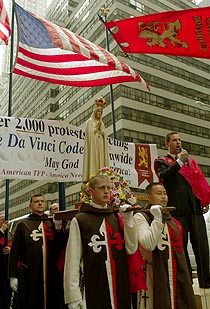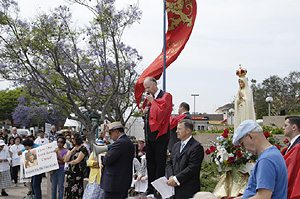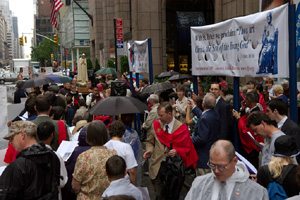The intermittent rain did not seem to matter. Neither did the traffic. Catholics just kept arriving in front of Sony headquarters on Madison Avenue in New York City.

In all, nearly 500 protesters braved everything to join the June 24 rally of reparation against The Da Vinci Code movie organized by the American Society for the Defense of Tradition, Family and Property (TFP) and its America Needs Fatima campaign. A similar rally with nearly 150 present was held at Sony Pictures in Los Angeles.
Somehow the New York rally was symbolic of the whole campaign against Sony’s The Da Vinci Code movie. Protesters faced all sorts of obstacles when organizing their vigils in front of theaters. They confronted peer pressure, discouragement and broken promises. They faced yells, screams and obscenities. They braved rain, heat and the elements. Yet the protests just kept coming.
The protesters did not back down. Relying on God and His Blessed Mother, they put together 2,092 vigils of reparation and protest nationwide. Some protests gathered together nearly 200 people. Others had dozens; some people protested alone. The important thing was that they were held. Protesters also organized over 1,000 Holy Hours of reparation on June 18. From coast to coast, in every state, it became very clear that Americans rejected blasphemy.
Barely a week after the release of what was billed as the year’s “most anticipated movie,” no one seemed to be talking about The Da Vinci Code anymore. In the United States, media coverage shrank to almost nothing. Within a month, attendance plummeted by 88 percent. As conservative Catholic columnist Austin Ruse quite aptly declared: “The Da Vinci Code is dead!” 1

Back Into the Public Square
The June 24 rallies were the culminating point of the American TFP’s long fight to reject The Da Vinci Code in both its book and film versions. Activists gathered at the two Sony headquarter locations to voice their concern and outrage to the corporate entertainment giant. The American TFP organized programs of speakers and prayers for the two-hour events.
Perhaps one of the most exciting aspects of the rallies was the fact that Catholics were literally bringing Christ and His Blessed Mother back into the public square from which they have been so ruthlessly excluded. In New York, a solemn procession with a statue of Our Lady of Fatima, escorted by members wearing the TFP ceremonial habit, made its way through the crowd that spilled out into the street. No one was ashamed to proclaim Christ before men.
Praying the rosary on Madison Avenue was especially memorable. Led by the strong voice of Father Gregory Karpyn of Girardville, Penn., protesters prayed loudly and joyfully, oblivious to the secular city surrounding them. Participants also sang hymns and shouted slogans such as “Viva Cristo Rey!” (Long Live Christ the King) that echoed off the skyscrapers.
Passersby were clearly not oblivious to the throng as they stopped to observe such a rare sight. A few Catholics joined the protests straight from the sidewalk. One couple from England upon learning of the protest cancelled their plan to buy a laptop at the nearby Sony store.

Setting the Tone
America Needs Fatima director Robert E. Ritchie presided over the New York program and announced the prayer intentions for the rally. His opening words set the tone of joyfully affirming the Catholic Faith in a hostile culture
For such a theme, there is no better speaker than Chicago’s pro-life activist Joe Scheidler. He reminded the crowd: “We are the Church Militant. We are not the Church sitting around. We are not the Church waiting to see things happen.” The fiery director of the Pro-Life Action League remarked how Catholics have not the option but the obligation to come to the Church’s defense when unjustly attacked.
Also speaking was Jason Scott Jones, media director from the pro-life organization, Human Life International in Front Royal, Va. “Our Civilization was founded on the Church. Our Church was founded on the Rock—Saint Peter by the Lord Jesus Christ,” Mr. Jones remarked. “Let us pray for the grace to always be at the foot of the Cross – with Our Lady and Our Church: Rain or Shine.” He also read a statement from HLI president Rev. Thomas J. Euteneuer which summed up the reasons for the protest: “At our baptism, we pledge to ‘reject Satan, and all his works and all his empty promises.’ Let us reject Sony’s Da Vinci Code the Movie!”
Joseph A. D’Agostino, vice president for Communications at the Population Research Institute also delivered some remarks against the blasphemous film.
The American TFP’s own Charles Preston Noell III closed the rally qualifying The Da Vinci Code as unacceptable and calling on all present to boycott the company. “Attacking the Divinity of Our Lord Jesus Christ, as The Da Vinci Code movie did, has consequences,” Mr. Noell concluded. “Send Sony a message by boycotting their products!”
In Los Angeles, TFP member Philip Calder led a similar program of prayers, hymns and addresses. Four protest organizers from different parts of the state gave accounts of their experiences. They too held a solemn procession that brought the Blessed Mother to the public square.1
Silence on the Cultural Left
The rallies highlighted the fact that a lot had changed since the first protests. In the weeks leading up to the May 19 worldwide launching, The Da Vinci Code was heralded as the year’s most eagerly awaited and controversial film. The movie was only the tip of the iceberg to all sorts of books, documentaries and reports denying Christ’s divinity. The media discouraged oppposition by repeating the myth that protests only fuel ticket sales.
Indeed, with all the publicity, the film had all the momentum and hype to make it a blockbuster even with its negative reviews at the Cannes Film Festival.2
On May 19, the movie opened with plenty of fanfare and impressive opening weekend ticket sales. Many TFP protester organizers nationwide were swamped by calls from reporters all too eager to report on grassroots reactions and their seemingly failed attempt to stop the popular movie from showing.
However, after the first weekend, the climate radically changed. Box office receipts fell astonishingly flat. The media were no longer interested in discussing so many of the “fascinating” religious issues they had long claimed the film raised. A deafening silence descended over the film.
By trying to satisfy everyone – especially offended Catholics, it appears that the film’s producers satisfied no one. Sony had tried to tread carefully to deflect criticism and ended up producing a skittish film that critic Jami Bernard of The New York Daily News called “nervous about offending anyone.”2
In the end, the final version still offended Catholics who protested outside theaters, while inside, Dan Brown fans were afflicted by a performance described by critics as “cumbersome,” “uninspired,” “wishy-washy,” “flat,” “jumbled” and “joyless.”
In other words, once the media perceived the film had no future, they abandoned the film to its own fate and moved on to other things.
Negative Publicity
In the debate as to whether protests fuel ticket sales, one fact does stand out. In the United States where there were over 2,000 protests in front of theaters, the film fell flat. However, the film did enjoy success in international markets where there were no protests.
Indeed The Da Vinci Code was The Passion of the Christ in reverse. American attendance accounted for a huge percentage of the total gross ticket sales of Mel Gibson’s film. In the case of The Da Vinci Code, Europe and the world saved the day, accounting for over seventy percent of total receipts.
Moreover, its lackluster performance in the United States jeopardizes the chances of the film winning awards in Hollywood. Negative publicity whether in theater protests or bad reviews seems to have stalled The Da Vinci Code juggernaut that seemed so unstoppable a few short months ago.
Looking beyond The Da Vinci Code
The somber silence surrounding The Da Vinci Code contrasted with the loud, joyous prayers and the honks of support by passing cars heard at the TFP rallies in New York and Los Angeles.
Protesters were not only praying in reparation but were celebrating their 2,092 protests where they witnessed for Christ before man. They were engaging not a film but today’s neo-pagan culture. Ironically, the film that tried to introduce doubts in dispirited Catholics had the opposite effect of energizing them with certainties. As one of the TFP banners read: “The Da Vinci Code Rejects the Divinity of Jesus Christ. We Reject The Da Vinci Code!”
“As far as I know, the magnitude of this act of public reparation is unparalleled,” commented TFP president Raymond E. Drake, present at the rally. “The moral outrage is real and Catholics proved it by forming the largest grassroots protest against blasphemy in our history.”
The Da Vinci Code book and movie may not be remembered as a significant film, but it will be remembered by countless American Catholics as a time when thousands of Catholics facing enormous obstacles stood up to today’s secular culture and proudly defended the honor of Our Lord and His Blessed Mother – and a time when they prepared for more battles yet to come.

